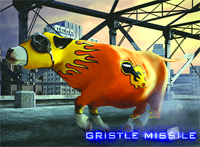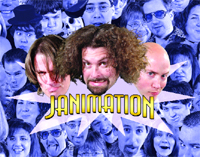
Ken McGorry
|
DALLAS - Despite the fact that Chick-fil-A's management is known for its rather staid temperament, the company has for many years relied on cows to sell the franchise's chicken-filet sandwiches. With their earnest and intentionally misspelled, "Eat Mor Chikin" slogan, the cows themselves have become something of an ironic icon, especially in Southern states where Chick-fil-A is a wholesome fast-food stalwart. There are even Chick-fil-A cow products for sale -
t-shirts, stuffed animals and a calendar, stuffed with Chick-fil-A coupons.
The franchise's agency, The Richards Group, also has a history of keeping its creative within accepted boundaries of taste. But sooner or later, I believe, we will all wind up in the thrall of 3D animators. And, when Chick-fil-A and The Richards Group emerged from their relationship with Janimation, based here, they had a herd of seemingly living, breathing "Cow Superheroes" pitching their calendar on TV to the strains of a dramatic track by NYC's Sacred Noise.
It's called misdirection (tricking viewers with its ominous mood) Janimation founder and chief creative director Steve Gaconnier points out, and he was delighted to be involved in the project. Stylistically, the :30's moody opening draws you into a threatening environment of urban decay redolent of an X-Men feature, including the bleak intonations of the narrator's line, "In a world driven by hunger..." Then the spot lurches into parody as seven of the "Cow Superheroes" appear posed together on all fours positioned in a phalanx. Janimation then singled out three of the cows with solo cutaways - "The Swatter," "The Gristle Missile" and "Cold Cuts."

Janimation's re-creation of the Chick-fil-A calendar Cow Superheroes as 3D animated characters relied on camera projection techniques.
|
The wacky doings culminate in a digitized calendar-page-flip effect emphasizing the $5 value and reprising the cows as monthly pin-ups.
TIME CONSTRAINTS
Gaconnier knew that his company had no time to re-create all the bovine characters from the ground up in 3D. Instead, Janimation pulled off the feat by scanning most of the calendar's cattle into their computer and then using "camera projection mapping" techniques to map the 2D images, created by the Glen Wexler Studio, onto their own 3D cow models. Wexler's calendar illustrations were combinations of stock photography, miniatures, Adobe Photoshop and more, so it was important to recapture their humorous details and textures onto 3D models. "We would literally project from the 3D camera onto these 3D wireframes," says animation director Greg Punchatz. "Normally this technique is very limited because you can't move the camera around very much because your camera's only projecting from one point - if you start to move the camera, you start to see the flaws."
Camera projection has been increasing in popularity since its use in creating environments for The Matrix, Punchatz points out. "We allowed more camera motion, after doing our camera projection, by figuring out a way to extract those texture maps in Softimage|XSI in an undistorted form and then repaint those textures in Photoshop and [Right Hemisphere's] Deep Paint." As Janimation's technical director, Ludovick Michaud, tells it, "Using image-based texturing we simply modeled the elements in 3D to match the separated layers of the images. Then we project the image onto the objects and freeze it on the 3D model. Of course, the image is 2D so when it goes onto the 3D model it has some stretching. Once you have your whole image completed, you can then animate your model to bring each character to life." That was the job for Punchatz and three other animators, John McInnis, Jeffrey Dates and John Griffith, all working in XSI.

SuperAnimators! (L-R): Greg Punchatz, Steve Gaconnier, Pete Herzog and staff.
|
Compositing effects, including lightning flashes and X-Men-style titles, were created by Jen Hudgens working in Apple Shake as well as Adobe After Effects and Avid|DS.
"We were able to take the fast-turnaround time by using the camera projection," says Gaconnier. "It allowed us to use very simple models. Otherwise we would have ended up with a complete 2D product; 3D brought so much more to the characters." Gaconnier was also happy to realize the script's dark opening and avoid an overly cartoon-y approach. "It's kind of goofy," he adds, "but we've presented them in such a way that these cows are into some serious stuff!" The client, seeing the final product, felt "this is way more than we expected to see," he says.
Gaconnier credits Janimation visual effects producer Pete Herzog as "the glue" who holds such jobs together, communicating back and forth between the client and the creative team. "He keeps everybody [at Janimation] in line, and lets them know immediately as additions and expectations change." Herzog worked closely with the agency. Since The Richards Group is considered a highly creative agency, Herzog says, "we wanted to really show our stuff." He credits collaborative brainstorming sessions as the key to coming up with the ideas that made the spot work.